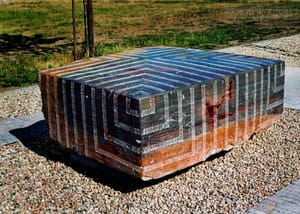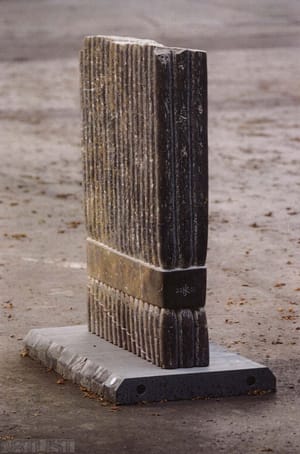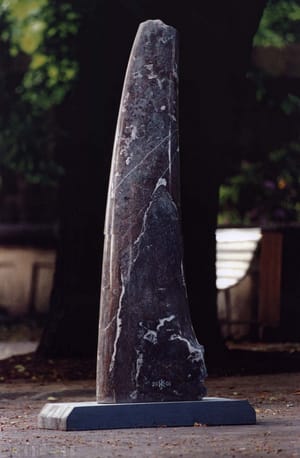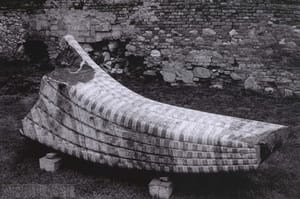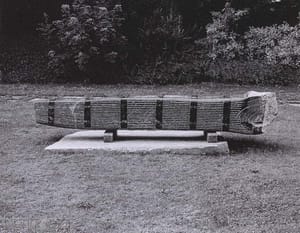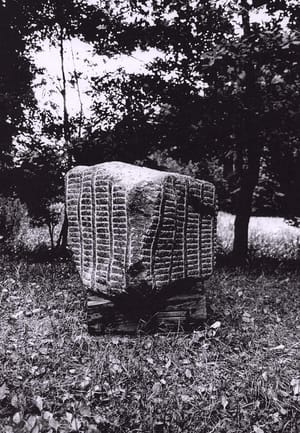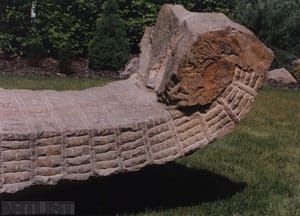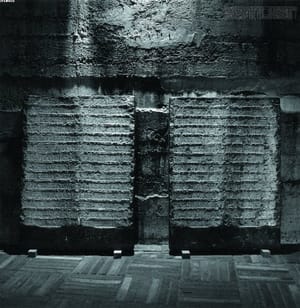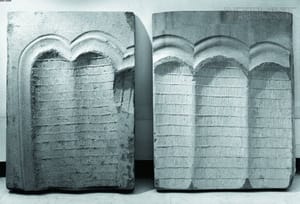- First Name
- Jiří
- Surname
- Kačer
- Born
- 1952
- Birth place
- Prague
- Place of work
- Hostivice
- Website
- www.jirikacer.cz
- Keywords
- CSU Library
- ↳ Find in the catalogue
About artist
The peak of Jiří Kačer’s output is the distinctive synthesis of two important and yet opposing viewpoints which appeared in post-war sculpture. The first of these is the phenomenon of the International Sculpture Symposia, which were created in 1959 by the Austrian sculptor Karl Prantl (here we would remind ourselves that Kačer also established and for several years organised the important symposium entitled Sculptural Encounters, based in Přední Kopanina), which fundamentally contributed to the rehabilitation of stone as a modern sculptural material. Prantl thought up not only his own form of symposium as a working meeting, but also promoted a certain type of symposium sculpture. Such sculpture was to be of an abstract character after the example of the cultic prototypes of the menhir, throne and commemorative stela. The sculptor should continue to work with the natural qualities of the stone, be these aesthetic, physical (since he realised the sculpture himself in accordance with the principle of taille directe) or content-related in the hieratical sense of the word.
The second source of Kačer’s inspiration is the figurative tradition. On the one hand this was Italian, specifically the classically rooted sculpture of Giacomo Manzu, an exhibition of whose work in Prague in 1973 had a powerful effect on Kačer, and on the other pop art, especially the work of the American sculptor Georges Segal, also seen from a Czech perspective as being related to the arrival of new figuration. Above all Jan Hendrych was important to Kačer, whom he had already assisted during his studies in Hořice while the former was chiselling his sculptures. However, he soon abandoned the full-volume sculpture of Segal-inspired character (Marcela, 1981, Back 1983) and moved over to relief, which became his main means of expression. Even his completely three-dimensional sculptures are based on the effect of relief-structured surfaces. The first stone reliefs still evoke body imprints (Back, 1983, Imprint, 1985), which was again an important theme in Czech new figuration (Eva Kmentová). In other sculptures the physicality disappears and the structure of the imprint begins to be reminiscent of architectural fragments or more often enlarged fossils of prehistoric anthropods. This represents the perfect intersection of two basic natural principles: the organic (animals, irregular forms) and anorganic (stone, the skeletons of animals, geometric structure), and thus the contradiction in terms of a “fingerprint in stone” is directly given voice. These sculptures are often intended to lean against something and the artist installs them using the same method by which renaissance tombs are presented in a lapidarium.
- Author of the annotation
- Marcel Fišer
- Published
- 2010
CV
Studies:
1975-1981 Academy of Fine Arts Prague, J. Bradáček and A. Nykl
1970-1974 Secondary / High School of Stone Sculpture, Hořice v Podkrkonoší
R. Šnajbr
1967-1969 Secondary / High School of Applied Arts, Prague
(plasterer department)
Symposiums:
2006 Castellina in Chianti, Itálie
2005
Sochařské setkání „Při zdi 2005“, Uherský Brod
Sochařské léto, Milevsko
2004 Kunsfeld Hetzmannsdorf, Rakousko
2003
Sochařské setkání „Při zdi 2003“, Uherský Brod
Cesta mramoru, Dobřichovice
2001 Kulturní most, Gerlesborg, Švédsko
2000
Schüttkasten Klement, Rakousko
Česká kamenná skulptura, Pražský hrad (Prague)
Džbán 2000. Mezinárodní sochařské sympozium, Hředle, Hředle (Rakovník)
1999
Žulové sympozium, Milevsko
Steinbildhauer Symposium, Prägraten, Rakousko
1998 Žulové sympozium, Jindřichův Hradec
1998-2001 Kámen a hvězdy, Hvězdárna Ondřejov
1996 Boháňka, Hořice v Podkrkonoší
1995 Cotangens, Praha (Prague)
1994 Cotangens, Adnet, Rakousko
1993 Hořice v Podkrkonoší
1992 1992 Džbán 1992. Mezinárodní sochařské sympozium, Hředle, Hředle (Rakovník)
1991 „It’s Open“, České Budějovice
1981-1987 Sochařská setkání, Přední kopanina, Praha
- Member of art groups included in ARTLIST.
Exhibitions
- Solo exhibitions
-
2012
Sedimenty paměti kamene, Galerie výtvarného umění v Mostě, chrám Nanebevzetí Panny Marie v Mostě
2010
Kameny. Galerie města Plzně, Plzeň (Pilsen)
2008
Jádra. Románské výstavní prostory, VS Husova, ČMVU Praha (Prague)
2007
Nová síň pod Vysokou bránou, Rabasova galerie, Rakovník
2006
Kameny. GMU Karlovy Vary
2004
Galerie 9, Praha (Prague)
2003
Univerzitní galerie, Plzeň (Pilsen)
2002
Skulptury. Letní míčovna Pražského hradu, Praha (Prague)
2001
Kameny. Středočeské muzeum Roztoky u Prahy
Jiné kameny Jiřího Kačera. Městské muzeum Hořice
1998
Sochy. Galerie V zahradě, Kolín
Nová galerie V. Kramáře, Praha (Prague)
1997
Sochy. Dům umění České Budějovice
Galerie Špejchar, Jindřichův Hradec (Neuhaus)
1995
Městské muzeum Milevsko
1993
Sochy a kresby. Rabasova galerie, Rakovník
Reliefy a kresby. Galerie Nová síň, Praha (Prague)
1992
Zámek Hostivice
MKS Třebíč
Galerie plastik, Hořice v Podkrkonoší
1991
Ústav makromolekulární chemie, Praha (Prague)
Galerie R, Praha
1983
Zámek Staré Hrady u Libáně
1982
Ústav makromolekulární chemie, Praha (Prague)
- Group exhibitions not included in ARTLIST.
-
2011
Terra (non)firma / (Ne)pevná půda, Galerie Kartografie, Praha (Prague)
2010
Smalt Art. Krajina, tělo, záření, Nostický palác, Praha (Prague)
Umělecká beseda: Pocta Bohuslavu Reynkovi, Galerie výtvarného umění v Havlíčkově Brodě, Havlíčkův Brod
2009
Věčná pomíjivost. Kostel Zvěstování Panny Marie, Litoměřice
2008
Zrozeno do prostoru. Hrad Sovinec
Pohledy do sbírek Severočeské galerie výtvarného umění v Litoměřicích. SGVU Litoměřice
2007
Vltavotýnské výtvarné dvorky 2007. Městská galerie Art Club, Týn nad Vltavou
Umělecká beseda. Vědomí o člověku. Výstavní síň Masné krámy, Plzeň
Umělecká beseda. Vědomí o člověku. Mánes, Praha (Prague)
Členská výstava Umělecké besedy. Novoměstská radnice, Praha
Členská výstava Umělecké besedy. Muzeum a galerie Orlických hor, Rychnov nad Kněžnou
2007-2008
Členská výstava Umělecké besedy. Galerie výtvarného umění, Most
2006
Cesta mramoru. Chodovská tvrz, Praha (Prague)
2005
Pocta Umělecké besedy Václavu Rabasovi. Rabasova galerie, Rakovník
IV. nový zlínský salon, KGVU Zlín
2004
Audabiac. Uměním ke svobodě. Francie
2003
Pučení. Plastiky a objekty v parku Podvinní. Praha (Prague)
2002
III. nový zlínský salon. KGVU Zlín
Art Safari 4. Sochařské studio Bubec, Praha (Prague)
2000
Česká kamenná skulptura 90. let. Pražský hrad, Praha (Prague)
1998
Grosse Kunstausstellung. Haus der Kunst, Mnichov, SRN
1994
Socha v kameni. K poctě Josefa Wagnera. Vojanovy sady, Praha
Cotangens. Engelhartszell, Rakousko
1993
Troja 93. Pražská botanická zahrada, Praha (Prague)
Příběhy bez konce. Princip série v českém výtvarném umění. Palác Kinských, Národní galerie v Praze (Prague)
Příběhy bez konce. Princip série v českém výtvarném umění. Místodržitelský palác, Moravská galerie Brno
1992
FIDEM. Londýn, Velká Británie
1991
Salon de Tokyo. Tokio, Japonsko
1990
Hapestetika, Praha - Brno
FIDEM. Helsinky, Finsko
1989
Salon de Tokyo. Tokio, Japonsko
Restaurátorské umění 1948 – 1988. Mánes, Praha (Prague)
II. Mezinárodní quadrienále medailí. Kremnica
1988
Současná česká medaile a plaketa. Berlín, NDR
Salón pražských výtvarných umělců 88. Park kultury a oddechu Julia Fučíka, Praha (Prague)
Mladí čeští sochaři k poctě Hany Wichterlové. Nová síň, Praha (Prague)
1987
Současná česká medaile a plaketa. Mánes, Praha (Prague)
Salon de Tokyo. Tokio, Japonsko
Rockfest. Palác kultury, Praha
Konfrontace VI. Špitálská ulice, Praha (Prague)
1986
Drobná plastika. Galerie Platýz, Praha (Prague)
1985
Vyznání životu a míru. Přehlídka československého výtvarného umění k 40. výročí osvobození Československa Sovětskou armádou. Praha (Prague)
Vyznání životu a míru. Přehlídka československého výtvarného umění k 40. výročí osvobození Československa Sovětskou armádou. Dom kultúry, Bratislava
1982
Mladí středočeští výtvarníci. Galerie U Řečických, Praha
- Collections
-
Národní galerie Praha, Zbraslav
Ministerstvo kultury ČR
Galerie Salon de Tokyo, Japonsko
Soukromé sbírky v České republice a zahraničí
Monography
- Articles
Magdalena Juříková, text katalogu výstavy Jiří Kačer, Nová síň, Praha, 1993
Peter Paszkiewicz a kol., text katalogu k sochařskému sympoziu Cotangens, Donau, Linz, 1994, s. 27–26
Peter Paszkiewicz a kol., text katalogu k sympoziu Serpentin – Steinbildhauer – Symposium,
Prägraten am Grossvenediger, 1999, s. 12–15.
Magdalena Juříková, text katalogu výstavy Česká kamenná skulptura 90. let,
exteriéry Pražského hradu, Praha, 2000
Peter Paszkiewicz a kol., text katalogu k sochařskému sympoziu Schüttkasten Klement 2000,
Klement, 2000, s. 18–21
Magdalena Juříková, Sochař a kámen. Kámen, 2001, č. III, 7. ročník
Jaroslav Vanča, text katalogu výstavy Jiné kameny Jiřího Kačera – Fragmentární tvary a ucelené myšlenky
Jiřího Kačera, Městské muzeum Hořice v Podkrkonoší, 2001
Magdalena Juříková, text katalogu výstavy Jiné kameny Jiřího Kačera,
Městské muzeum Hořice v Podkrkonoší, 2001
Ivan Neumann, Svědkové trvání, sochařská tvorba Jiřího Kačera. Prostor, Zlín, 2003, č. 2, 10. ročník, s. 18–21
Kateřina Vozárová, Sochařské setkání Při zdi 2003 – Uherský Brod. Prostor Zlín, 2003, č. 2, 10. ročník, s. 22–23
Magdalena Juříková, text katalogu akce Kameny a hvězdy, astronomický ústav AVČR, Praha, 2004
Pavlína Pyšná, Sochařské setkání Při zdi 2005 – Sochařské setkání v Uherském Brodě.
Prostor Zlín, 2006, č. 1, 13. ročník, s. 21–23

